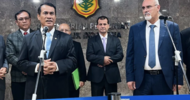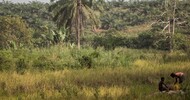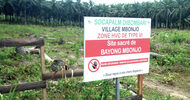Deutsche Welle | 20 November 2018
The colonial empire of Japan and the origins of the ProSavana agricultural project in Mozambique
by Johannes Beck
(Translated by GRAIN)
The colonial empire of Japan and the origins of the ProSavana agricultural project in Mozambique
by Johannes Beck
(Translated by GRAIN)
The Triangular People's Conference on ProSavana in Tokyo (November 20-22, 2018) brings together representatives of various non-governmental organizations and research institutions from the three countries whose governments gave rise to the ProSavana project: Mozambique, Brazil and Japan. Brazil's contribution to the project in Mozambique and the way the project was modelled on the conversion of the Cerrado (central-west of Brazil) into a soybean production zone are well known.
Less well known, but perhaps even more important, is the historical contribution of Japan. It goes back about a hundred years in the colonial history of Japan. At that time, the Japanese company Mitsui was even involved. Today in Mozambique, Mitsui owns 50% of the railway line of the Nacala Corridor, where the ProSavana agricultural project is being developed (the other 50% is owned by the Brazilian company Vale).
DW Africa spoke with Japanese researcher Sayaka Funada-Classen before the conference began.
DW Africa: Why was the third Triangular People's Conference on ProSavana organised in Tokyo?
Sayaka Funada-Classen (SFC): As you know, ProSavana is a development model that wants to transform the interior of Africa into a place of production of raw materials, so-called commodities. This is what is happening in Mozambique and in Brazil, in the Brazilian Cerrado. Well, who is behind these two programs? It's Japan! Not only private companies, but also a Japanese public fund. That is why it is important that the people of the local communities affected by these gigantic development models come to Japan and raise their voices so that the ordinary Japanese, who are paying for it, can understand what is happening far from Japan.
DW Africa: Could you describe a little more about this development model that Japan implemented in the Brazilian Cerrado with Prodecer and that it is now trying to implement in Mozambique with ProSavana?
SFC: So we have to look back to history. We are talking about ProSavana or the Nacala Corridor Development in Northern Mozambique. Nacala is a port and the end point of the Nacala Corridor, which is a railway line that connects the interior of northern Mozambique to the port. It especially connects the coal mining areas [in Tete province] with the port of Nacala. Along the way there are huge areas of agricultural lands and also areas of forest plantations.
When we talk about ProSavana, we tend to forget this image. But it is important to remember that ProSavana is one of the small programs of this whole development program called "Nacala Economic Corridor Development Program". And we have a historical origin for that, unfortunately.
DW Africa: When did this Japanese story begin?
SFC: A hundred years ago, in the early 20th century, we [the Japanese] brought the same kind of development model to northeast China. At the time, we used to call that area "Manchuria". There, Imperial Japan established a railway line linking the coal mining zones to the port and then developed soybean fields. So those who were involved in this gigantic regional development program were Japan's public railway company, banks, and also companies like Mitsui Corporation. Today, we call these "Public-Private Partnerships," which are supposedly good things.
ProSavana also started as a private-public enterprise initiative. But this has a historical origin! During Japan's imperial colonial period, Japan's public and private sectors went hand in hand, planning and accelerating such regional corridor development programs. This is why we can call what happened in Manchuria "the first ProSavana program".
DW Africa: What did Japan do in Manchuria about a hundred years ago?
SFC: Manchuria or the northeastern part of China was famous for dense forests and huge trees, where even many tigers lived. The first thing they did was to cut down all the trees and then use the wood to build the railroads. And they also sent the logs out to get a lot of money, to develop coal mining and then to produce soybeans on a large scale. The forest is gone. They took out all the trees because they had to plant soybeans. So in environmental terms the impact was enormous. The contamination of the air by burning coal was another problem that happened.
DW Africa: And in Brazil, with the development of agriculture in the Cerrado region, did Japan also have influence?
SFC: Yes, in the 1970s, Japan faced a crisis. We couldn't import enough soybeans. Currently, about 90% of our soybeans are imported. In the 1970s, this percentage was lower, but we still depended on foreign imports. So we faced a very difficult crisis. Thus, the Japanese government signed an agreement with the Brazilian government - at the time a military dictatorship - to transform the Brazilian Cerrado into a soybean production site for Japan. This program was called Prodecer and was taken to the region in the 1980s. At the time, the Cerrado was still an area famous for its dense forest. Even the name indicates this: because cerrado means "closed", therefore difficult to access because of the many trees.
There are many Japanese emigrants in Brazil. When Japan sent Japanese emigrants to Manchuria in 1930, it also sent another group of emigrants to Brazil. And after World War II, the Japanese government continued to send emigrants to Brazil. But they had no land, so they looked at the Cerrado. At that time, the Cerrado was not an agricultural zone: it was covered by dense forest and it was also thought that it was not good for agriculture because of the acidity of the soils. But by using chemical fertilizers they realized that they could transform the soil into productive land.
So, for the Japanese government, it was a great idea to take the model that had already been tried in northeast China to the Brazilian Cerrado. But then it became a political problem. Because the Brazilian government had to face criticism from the people who concerns about Japan and Japanese imperialism. They thought it would be a new colonization by the Japanese in the middle of nowhere in Brazil. The Prodecer was originally for the Japanese, but they had to change the tone and then what they did was also invite Brazilian migrants who were in southern Brazil to go out looking for land.
Then they needed a port so that the soybeans could be exported. Japan could not develop the rail links as they had in Manchuria, because Manchuria was under the influence of Japan and later was even occupied by Japan. Therefore, it was easy to bring this model of regional development to Manchuria. But in the case of Brazil, they failed to apply this same model after World War II and after the end of colonialism. It was a difficult job and, in the end, Japan did not manage to import the soybeans produced in the Cerrado. The American company Cargill and China received the soybeans. As a lesson, Japan felt it was important to take control of logistics as well, and not just on the production side.
DW Africa: What's happening now with Japan? Are Japan and JICA (Japan International Cooperation Agency) still interested in carrying out ProSavana? The Japanese side is even more important, because the Brazilians have laergely pulled back from the trilateral project.
SFC: They [JICA] officially say nothing or say that the process is important. But informally everyone says it was a terrible idea to think that it would be possible to take the success of Brazil and the Brazilian Cerrado to Africa, namely Mozambique. But everyone also says that we can't stop. Not only to avoid losing face, but we still have the same government in Japan that we have had for the last six years. This is the other reason why the Japanese Government is not stopping the program. But if we focus too much on ProSavana, we may overlook other terrible things that can happen in the northern region of Mozambique.
As I said, that kind of model will cause a lot of environmental and social damage. And unfortunately it is already happening in several areas in Zambezia province. There, many people were expelled because of a private company, owned by a former Mozambican President who works with a Brazilian soy company to open soybean fields for export.
DW Africa: Why is that possible?
SFC: Because our public fund and the Japanese private company Mitsui have expanded and renovated the railroad and the port. Without that [railroad and port], it would be impossible for any private company to open so much land and drive people away. It's impossible to make a profit if they had to transport the soybeans they produce by trucks, which have a much higher cost than the railroad. So the railroad facilitates transformation. And this is a transformation that we took to Brazil and, a hundred years ago, to a part of northeastern China. We are repeating our history and, as a citizen of Japan, I would like this history to come to an end.














